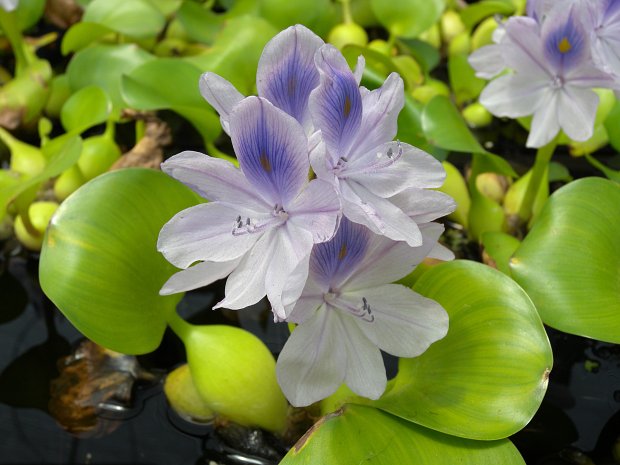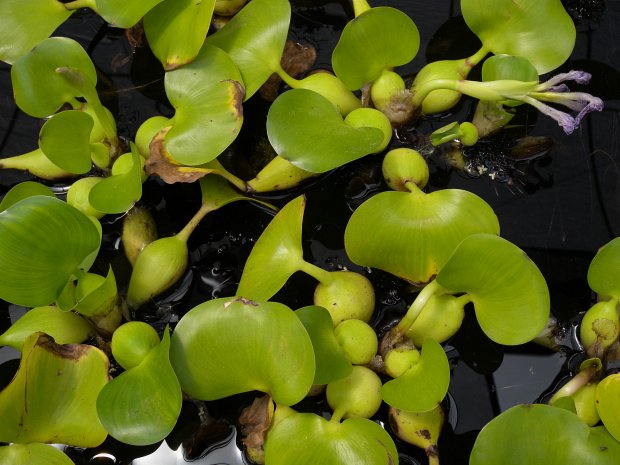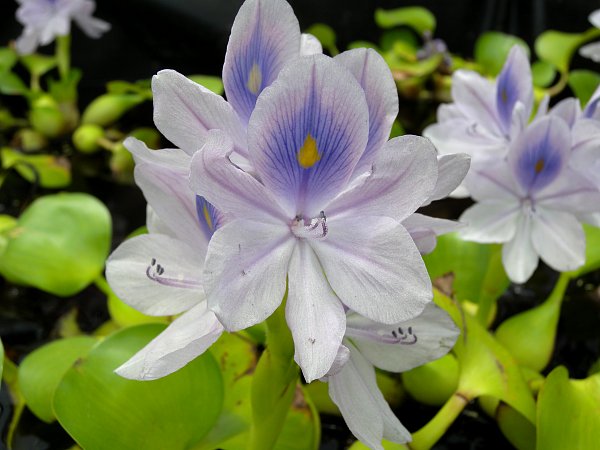
Each flower spans about 2-2½" across when it is fully open, consisting of 6 lavender tepals (rarely white or purple), 6 stamens (3 long stamens & 3 short stamens), and a 3-celled pistil with a single long style. In the center of the uppermost tepal, there is a patch of purple with a large yellow dot. The tepals have faint veins. The stout pedicels are up to 1" long, light green, and glandular-hairy. In a temperate climate, the blooming period can occur from mid-summer to mid-autumn (throughout the year in tropical climates), although the flowers of an individual plant remain in bloom for only a few days. These flowers are diurnal, opening up during the morning and withering by evening. Afterwards, the floral stalk bends downward into the water, where the seed capsules develop. Each capsule contains several seeds about 1-2 mm. in length and about one-half as much across; they are broadly oblongoid, ribbed, and pointed at one end. The seeds are distributed by water. The root system consists of a crown with feathery fibrous roots. These roots are purplish black and suspended in the water. Clonal daughter plants are often produced by stolons along the surface of the water. Colonies of floating plants often develop.
Cultivation: The preference is full sun and stagnant or slow-moving water that contains adequate amounts of absorbable nitrogen and mineral compounds. This plant is an aggressive colonizer in subtropical and tropical climates. In most of Illinois and other areas with colder temperate climates, Water Hyacinth rarely, if ever, survives the winter, although it may reseed itself from time to time. This plant tolerates water that has become polluted by heavy metals, but it does not tolerate brackish water and salt water.

Range & Habitat: The introduced Water Hyacinth rarely naturalizes in Illinois. So far, it has been reported from Massac County near the southern tip of the state (see Distribution Map). A colony of this plant has also been found in Vermilion County of east-central Illinois, but it is unlikely to survive the winter at this location. Water Hyacinth is native to tropical and subtropical areas of South America. It was introduced into North America as an ornamental plant for water gardens. In southeastern United States and southern California, it has escaped from cultivation to become a serious invasive pest, clogging canals and other waterways. It has also become a pest on other continents in tropical and subtropical areas. Habitats include canals, ditches, marshes, lakes, ponds, and slow-moving rivers. Bodies of water in both degraded habitats and high-quality natural areas can be invaded by this plant in part because it has few natural enemies outside of its native range.
Faunal Associations: The pollinators of the flowers are not well-known, but they are probably similar to those of the native Pontederia cordata (Pickerelweed), such as hummingbirds, long-tongued bees, and butterflies. Two native insects feed on the foliage or suck plant juices from Water Hyacinth: they are the larvae of Bellura densa (Pickerelweed Borer Moth) and Rhopalosiphum nymphaeae (Water Lily Aphid). Some insects have been introduced into North America as biocontrol agents of Water Hyacinth: they are Neochetina bruchi (Chevroned Water Hyacinth Weevil), Neochetina eichhorniae (Mottled Water Hyacinth Weevil), the larvae of Sameodes albiguttalis (Water Hyacinth Moth), and the planthopper Megamelus scutellaris. These biocontrol agents have been only partially successful in controlling populations of this invasive plant. Two native turtles, Stenotherus odoratus (Stinkpot) and Trachemys scripta (Slider), feed on the foliage of Water Hyacinth (Ernst et al., 1994).

Photographic Location: A water garden in Champaign, Illinois.
Comments: The swollen petioles and its floating habit make this aquatic plant relatively easy to identify, even when an inflorescence is not present. The flowers of Water Hyacinth have a similar structure and coloration to those of Pickerelweed (Pontederia cordata), except the flowers of the latter are much smaller in size. Pickerelweed also differs by being an emergent aquatic with non-swollen petioles. Besides the well-known Water Hyacinth, there are other Eichhornia spp. in South America, but they have not appeared thus far in natural areas of Illinois.